DIY dehydrated dog treats: Easy recipes to make for your pooch
These recipes for dehydrated dog treats are nutrient-dense, packed full of flavor, and are sure to earn you a huge paws up from your pooch

Whipping up a batch of dehydrated dog treats is well worth it if you're looking to add some variety to your pup's diet and are keen to try out a fun new way to get those all-important vitamins and minerals into their tummies.
There's definitely nothing wrong with the best dog treats lining the supermarket shelves, but the benefit of dehydrating is that you know exactly what your putting into your mutt's mouth. Dehydrated foods are also nutrient-dense and are free from preservatives and chemicals, making them a great choice if your furkid has allergies.
Learning how to make your own homemade dog treats is a really special way to show your pup some extra love and dehydrated treats provide them with a different taste and texture to what they're used to.
Below you'll find step-by-step instructions on how to make some of our favorite dehydrated dog treats, including sweet and savoury options to suit every taste bud.
- DIY peanut butter dog treats
- Three delicious diabetic dog treat recipes
- DIY vegan dog treats: 4 tail-waggingly good tasty bites
1. Vegetable medley
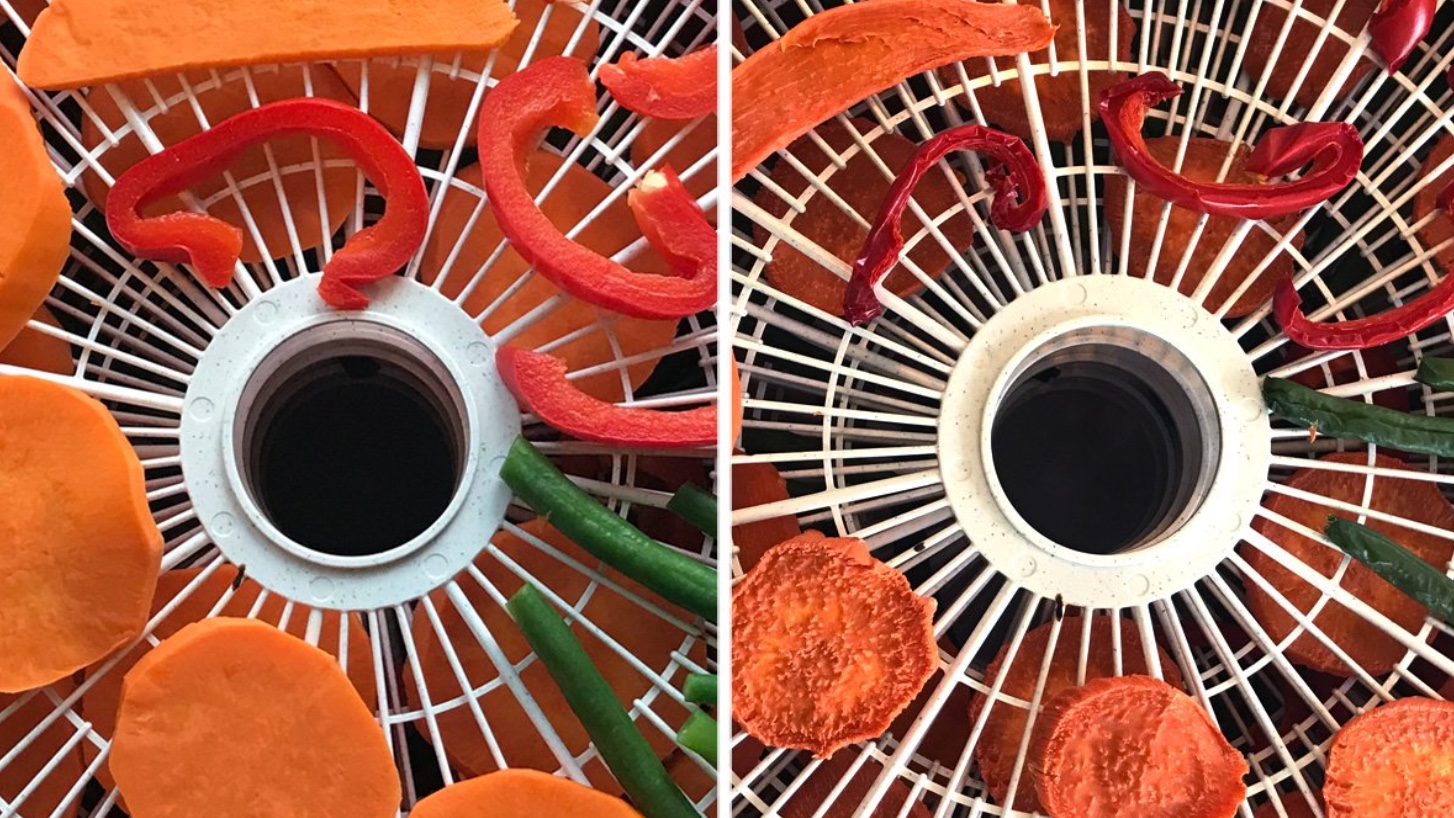
Ingredients:
- 2 large sweet potatoes
- ½ pound green beans
- 2 red bell peppers
Method:
- Fill a stockpot about three-quarters full of water and set to boil. If the water boils before you’re done prepping, just turn it down to medium-low until you need it. It will perk back up quickly.
- Rinse all your veggies well.
- Snap or snip the ends off your green beans and set aside.
- Peel sweet potatoes and slice into 1/4″ pieces, rounds, or strips. If you have a mandoline, this step goes quickly.
- Put green beans and sweet potatoes in boiling water to blanch for 4 minutes.
- Add ice and cold water to a large bowl to drain blanched veggies when they’re ready.
- Prep sweet bell peppers by removing seeds and white pith. Slice into 1/4″ strips.
- Remove beans and potatoes when done by dipping a long-handled strainer into the boiling water, draining a second, then pouring veggies into ice-bath.
- When all veggies are removed from boiling water, add the bell pepper strips and blanch for 1 minute, then add to ice bath.
- When all veggies are cooled, proceed to the drying stage.
- On a large cookie sheet or sheet pan, place a clean dry tea towel or two layers of paper towel.
- Place cooled veggies onto the dry towel, adding another towel on top and another layer of veggies on top of that until the veggies are nestled in. Pat or squeeze gently.
- Layer dried veggies onto dehydrator trays, taking care to make sure nothing is touching.
- Dehydrate between 110-140 degrees for at least 8 hours.
- If you want your sweet potatoes chewier, you can pull them out and continue drying your other veggies to the crisp stage.
- When fully dehydrated, allow veggies to cool to room temperature, then pack loosely in an airtight container or bag.
Notes:
- For crisper veggies, keep them in the dehydrator longer.
- You can use your oven instead of a dehydrator, set to lowest possible setting and start checking dryness at 4 hours and every 30 minutes or so thereafter.
- Veggies dried crisp will last longer than veggies dried to the chewy state.
- Chewy veggies should be eaten in the next couple days or kept in the fridge ideally.
- Crispy dried veggies should last 2 weeks in an airtight container.
2. Apple treats
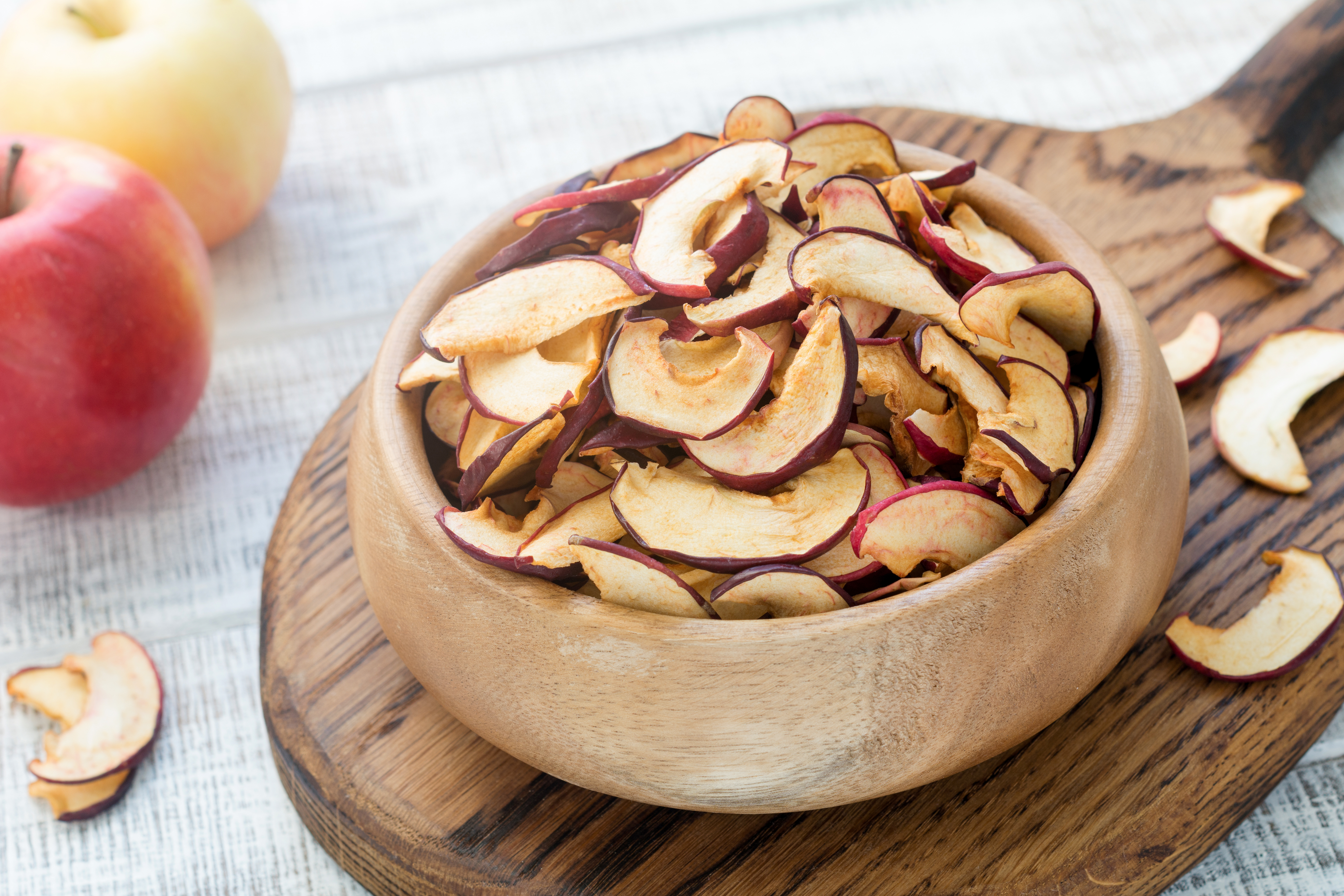
Ingredients:
- 2.5lbs organic apples
- 1 ½ ground cinnamon
Method:
- Wash, peel and core apples
- Slice apples thin and even, about 1/4" with a mandolin or knife
- Lay sliced rings on dehydrator trays, leave a small amount of space around each slice to allow air to circulate
- Sprinkle apple slices with a very light dusting of cinnamon
- Dehydrate at 135°F (57°C) for 6 to 8 hours, check at the 6-hour mark and continue to dry depending on the desired texture and if they will get eaten fast or stored
- Check for, both inside and outside of rings, ideally slices will feel dry and leathery without being sticky
- Tear an apple slice in half to check for moisture on the inside, it should resemble a dry sponge-like texture
- Once done, cool for several hours and store in an airtight bag or container - make sure they are completely cool so as not to create any moisture
- Give one to your pup, and to yourself and then store the rest in a dry, cool, dark place for up to a month
3. Jerky treats
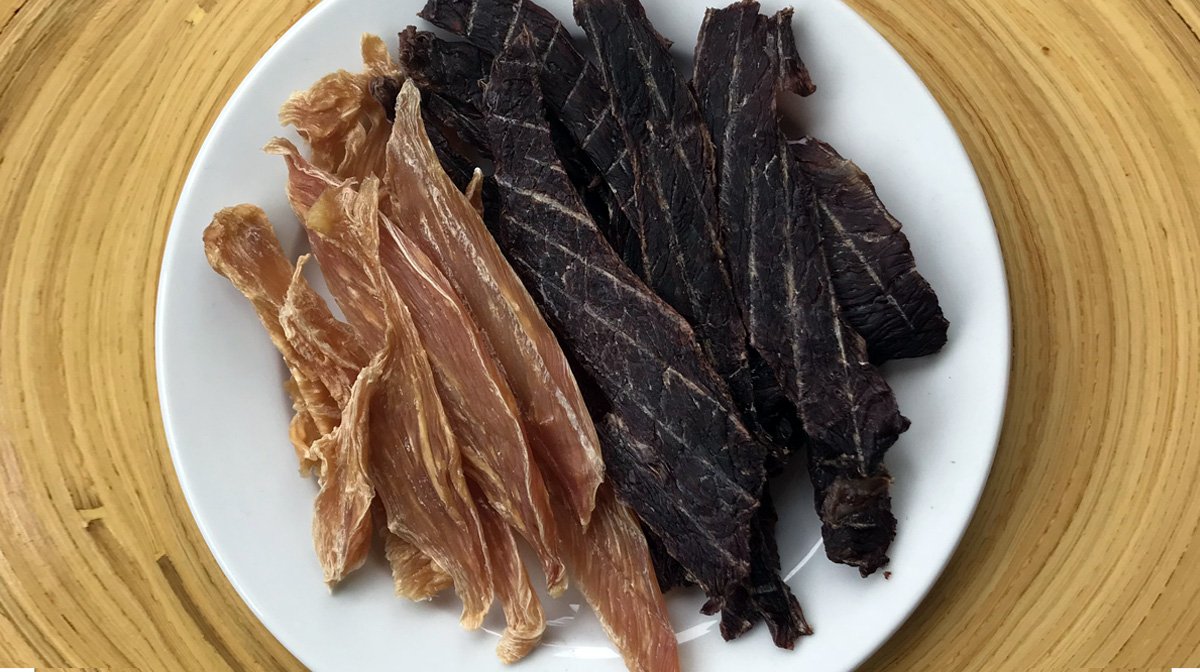
Ingredients:
Protein options
- A lean cut of beef like flank steak with little or no marbling
- Chicken breast or thigh (there will some fat trimming for thigh but we all know it’s tastier than breast!)
- Salmon (it’s a fatty fish so you’ll want to keep this jerky in the fridge but your dog will go WILD for the flavor). Check for bones and remove with tweezers.
- Any white fish. Check for bones and remove with tweezers.
Marinade:
- 1 cup unsweetened pineapple juice
- 1/2 cup liquid aminos (this is like low-sodium, gluten-free soy sauce you can find in the health food section of your grocery store. You can substitute with low-sodium soy sauce if you can’t find this product in your area)
- 1/2 cup apple cider vinegar
- A splash of fish sauce
- A pinch of powdered ginger
Method:
- Mix up your marinade. You will need one batch of marinade per pound of meat.
- Prep your lean meats by first removing all visible fat and discarding.
- Slice your proteins into whatever shape you like, bearing in mind that thinner cuts will dehydrate faster.
- Place your protein in the marinade, stirring to make sure everything is evenly covered.
- Marinate in the refrigerator for 4-24 hours.
- When you’re ready to dehydrate, preheat your dehydrator to 160 degrees F, or your oven to 160 degrees F or your lowest setting.
- Remove all the trays from your dehydrator. You don’t want to get raw meat juice all over the trays you aren’t using and it will increase airflow dramatically.
- Strain protein from marinade, patting dry with a paper towel.
- Place sliced meats onto trays, making sure to leave enough room between every piece for good airflow.
- Place trays in the dehydrator leaving good space between each tray if you can.
- Set timer for 4 hours.
- Check for doneness at 4 hours for the dehydrator, 3 hours if you’re using the oven since the temp will likely be higher. You want to see the meat shrunk by at least half, dark and consistent in color, and dry all the way through. The meat should bend but not feel rubbery or puffy (chicken, I’m looking at you).
- When meat is completely cooled, store in an airtight container.
Note:
Jerky will keep for one week on your counter or two weeks in the fridge. If you want it to last for a couple of months you could use a vacuum sealer. But we’re pretty sure your dog will help you make it disappear in a matter of days, if not hours.
4. Peanut butter banana chips
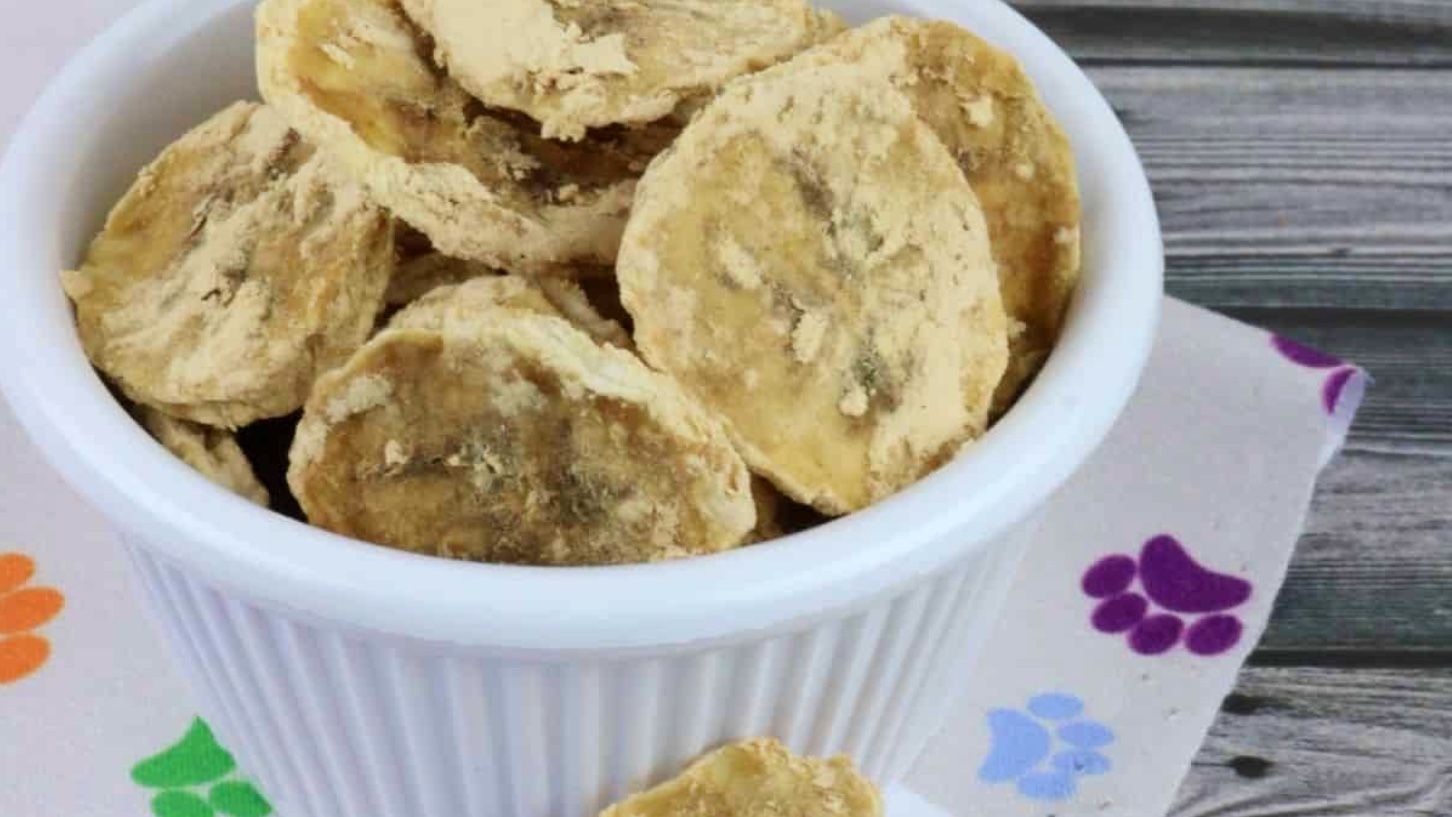
Ingredients:
- 1 overripe banana
- ½ cup powdered peanut butter
Method:
- Slice banana into slices that are about as thick as a quarter. The thinner the easier it is to dehydrate.
- Coat each slice with the peanut butter powder. Coat on the front and back.
- Place slices on the dehydrator tray so that they are not touching and evenly spaced out.
- Place the tray on the dehydrator and put the lid on. Set the temperature to 135 and the time for 8 hours.
- When it is about halfway done, flip all the slices over.
5. Dehydrated sweet potato chews
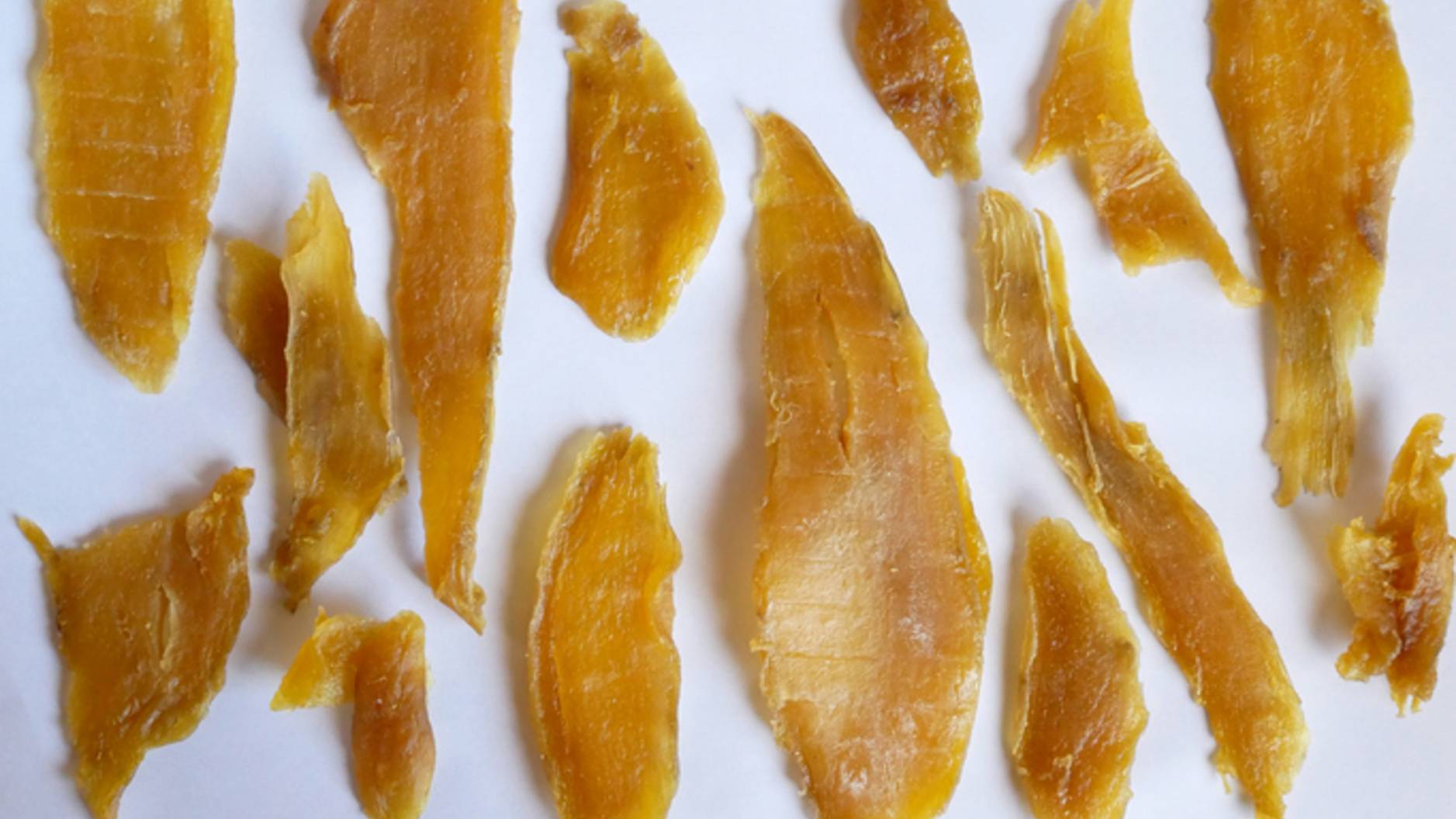
Ingredients:
- 2 large sweet potatoes
Method:
- Wash and dry the sweet potatoes
- Horizontally slice the sweet potato in about half inch slices using a large knife
- Spread the slices out on a baking tray and place in oven at the lowest temperature
- Flip the slices every hour until you get the desired chewiness (about 4-6 hours)
6. Easy dehydrated chicken jerky

Ingredients:
- 1 chicken breast
Method:
- Slice the chicken breast into long strips
- Place on a piece of parchment on a baking sheet
- Bake at 170F for 6-8 hours ensuring the texture is firm but not rock hard.
- Store in the fridge
- Slice into training size treats.
PetsRadar Newsletter
Get the best advice, tips and top tech for your beloved Pets

Kathryn is a freelance writer who has been a member of the PetsRadar family since it launched in 2020. Highly experienced in her field, she's driven by a desire to provide pet parents with accurate, timely, and informative content that enables them to provide their fur friends with everything they need to thrive. Kathryn works closely with vets and trainers to ensure all articles offer the most up-to-date information across a range of pet-related fields, from insights into health and behavior issues to tips on products and training. When she’s not busy crafting the perfect sentence for her features, buying guides and news pieces, she can be found hanging out with her family (which includes one super sassy cat), drinking copious amounts of Jasmine tea and reading all the books.
